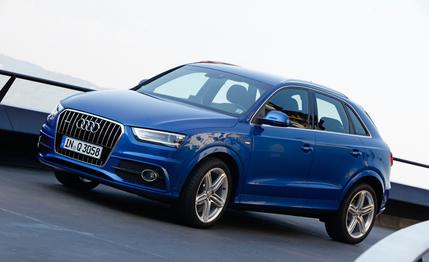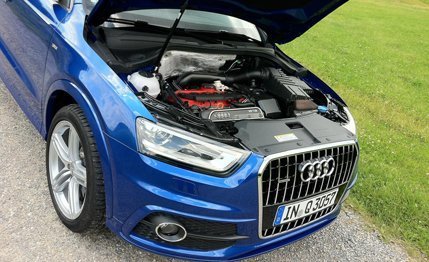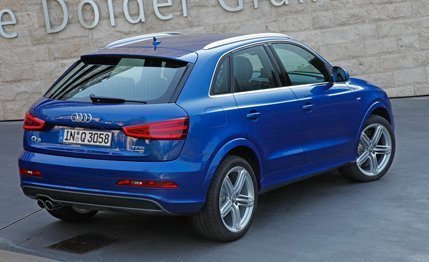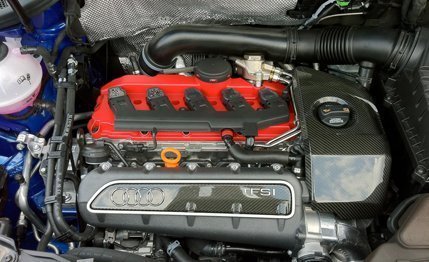 First Drive Review
First Drive Review
Not content with the success of the Q5, Audi is launching an even smaller crossover to compete with the BMW X1 and Acura RDX. The Q3’s underpinnings started with the VW Tiguan platform, but the architecture was significantly altered to be considered worthy of Audi’s four interconnected rings. “We have taken the most suitable parts from the components bin, and its architecture is basically a mix of the PQ46 [Passat, CC] and PQ35 [Tiguan, Mark VI Golf] platforms,” says development coordinator Thomas Soppa.
The electronics systems are largely taken from the A3 Sportback, and the front subframe and suspension are taken from the TT. Audi worked hard on reducing weight. The engineers used tailored blanks and high-strength steel for the passenger cell, and the hood and the hatch are aluminum. As a result, Audi’s version is said to be more than 130 pounds lighter than its VW sister model.

Engine choices for the Q3 are, for the most part, four-cylinders. The entry-level engine, a 140-hp, 2.0-liter turbo-diesel, is only available with front-drive, but at 236 lb-ft, it is so torquey that extra wear on the tires might offset any savings in the showroom or at the pump. With the 177-hp version of the turbo-diesel, the fully variable, third-generation Haldex all-wheel-drive system is obligatory. The same goes for the two 2.0-liter turbocharged gas engines, which make 170 and 211 hp. The less powerful diesel and gasoline mills come standard with the MQ350 six-speed manual, whereas the burlier engines come with the DQ500 seven-speed dual-clutch transmission. A hybrid model is possible but isn’t in the works. Audi isn’t currently planning to bring the Q3 to the hybrid-friendly U.S.—although there is still a chance—and European buyers are content with their diesels.
The “drive select” system, which allows the driver to fiddle with vehicle parameters, comes with an efficiency mode that packs some neat tricks. Lift off the throttle in cars with the dual-clutch transmission, and the clutches disengage for a “sailing” effect. In other driving modes, the system doesn’t manipulate the transmission, but it changes throttle response, power steering assist, and—if so specified—damping rate. A stop/start system is standard.

Although it’s not exactly in a different league from the already sporty Tiguan, the way the Q3 drives is rather impressive. With its front-drive layout, the entry-level model is a quick and reasonably comfortable cruiser, its diesel engine emitting a pleasant purr that other carmakers, particularly Asian ones, have yet to match. Truly quick it isn’t, but the fuel consumption is fantastically low, even when you’re not driving like an obstacle in the road. The electric power steering seems a tad more direct and precise than the Tiguan’s, and the XDS system, which simulates a limited-slip differential, suppresses the vehicle’s urge to understeer quite well.
What could elevate the Q3 beyond the Tiguan is the 2.5-liter single-turbo inline-five developed for the TT RS and subsequently installed in the RS3. For reasons that are not quite clear—and, frankly, not important—the five will find its way into the Q3 only slightly detuned, from 340 hp to something in the neighborhood of 310. The exact horsepower rating is not yet confirmed, but Audi tells us that the engine and the auxiliary hardware carry over from the RS cars. The horsepower difference is due to different engine mapping. The turbo five churns out 310 lb-ft of torque from a low 1600 rpm and will be coupled to the DQ500 dual-clutch gearbox from other Q3 models but also the RS 3 and the TT RS.

Although the five-cylinder turbo model is still technically in development, we were allowed to take a prototype for an extended drive. The characteristic five-pot growl is only slightly more subdued than on the RS 3, meaning it is still clearly audible from in- or outside the car. Throttle response is immediate, and the car charges forward. Audi reps suggested that this Q3 will reach 60 mph in about five seconds and top out at a governed 155 mph. More than just the drivetrain is upgraded in the five-cylinder model, as we noticed when attacking corners, where it stays absolutely neutral, with significantly less body roll than in other Q3s.
Audi contemplated using one of its high-output 2.0-liter fours as the top engine in the Q3. Although it could have achieved the same power level with one of the four-cylinders, we applaud Audi’s decision to go with the five. The engine’s sound and character set it apart from the competition, especially the upcoming BMW X1 xDrive35i with its 300-hp N55 single-turbo inline-six. That’s a sweet engine as well, but with a far more civil personality.
Right now, the most powerful engine in the Q3 lineup is camouflaged by a regular body with the S line package—and that might remain the case when it launches. But given that this is an RS engine developed by Quattro GmbH, we’d say it is at least worthy of the Q3 S or SQ 3 moniker, and not just a 2.5 TFSI badge and S line body cladding. We hope the Q3 will make it across the Atlantic, but what we really want is for Audi to bring along the fantastic five.